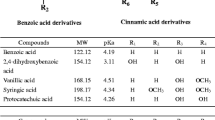Abstract
This paper describes a fast and sensitive method for the determination of methyl, ethyl, propyl, and butylparaben in hair samples by capillary electrophoresis using automatic reverse electrode polarity stacking mode. In the proposed method, solutions are injected using the flush command of the analysis software (940 mbar) and the polarity switching is carried out automatically immediately after the sample injection. The advantages compared with conventional stacking methods are the increased analytical frequency, repeatability, and inter-day precision. All analyses were performed in a fused silica capillary (50 cm, 41.5 cm in effective length, 50 μm i.d.), and the background electrolyte was composed of 20 mmol L−1 sodium tetraborate in 10 % of methanol, pH 9.3. For the reverse polarity, −25 kV/35 s was applied followed by application of +30 kV for the electrophoretic run. Temperature was set at 20 °C, and all analytes were monitored at 297 nm. The method showed acceptable linearity (r 2 > 0.997) in the studied range of 0.1–5.0 mg L−1, limits of detection below 0.017 mg L−1, and inter-day, intra-day, and instrumental precision better than 6.2, 3.6, and 4.6 %, respectively. Considering parabens is widely used as a preservative in many products and the reported possibility of damage to the hair and also to human health caused by these compounds, the proposed method was applied to evaluate the adsorption of parabens in hair samples. The results indicate that there is a greater adsorption of methylparaben compared to the other parabens tested and also dyed hairs had a greater adsorption capacity for parabens than natural hairs.



Similar content being viewed by others
References
Bledzka D, Gromadzinska J, Wasowicz W (2014) Parabens. From environmental studies to human health. Environ Int 67:27–42
Routledge EJ, Parker J, Odum J, Ashby J, Sumpter JP (1998) Some alkyl hydroxy benzoate preservatives (parabens) are estrogenic. Toxicol Appl Pharmacol 153(1):12–19
Oishi S (2001) Effects of butylparaben on the male reproductive system in rats. Toxicol Ind Health 17(1):31–39
Darbre PD, Aljarrah A, Miller WR, Coldham NG, Sauer MJ, Pope GS (2004) Concentrations of parabens in human breast tumours. J Appl Toxicol 24(1):5–13
Shanmgam G, Ramaswamy BR, Radahakrishnan V, Tao H (2010) GC-MS method for the determination of paraben preservatives in the human breast cancerous tissue. Microchem J 96(2):391–396
ANVISA, Resolution no. 162, 09/11/2001
European Parliament and of the Council of 30 November 2009 on cosmetic products; European Union Regulation No. 1223/2009: 2009; 59-209
Nishizawa C, Takeshita K, Ueda J, Nakanishi I, Suzuki KT, Ozawa T (2006) Reaction of para-hydroxybenzoic acid esters with singlet oxygen in the presence of glutathione produces glutathione conjugates of hydroquinone, potent inducers of oxidative stress. Free Radic Res 40(3):233–240
Barba C, Mendez S, Marti M, Parra JL, Coderch L (2009) Water content of hair and nails. Thermochim Acta 494(1-2):136–140
Pazourekova S, Hojerova J, Klimova Z, Lucova M (2013) Dermal absorption and hydrolysis of methylparaben in different vehicles through intact and damaged skin: using a pig-ear model in vitro. Food Chem Toxicol 59:754–765
Caon T, Costa ACO, Oliveira MAL, Micke GA, Simoes CMO (2010) Evaluation of the transdermal permeation of different paraben combinations through a pig ear skin model. Int J Pharm 39(1-2):1–6
Huang JQ, Hu CC, Chiu TC (2013) Determination of seven preservatives in cosmetic products by micellar electrokinetic chromatography. Int J Cosmet Sci 35(4):346–353
Dolzan MD, Spudeit DA, Azevedo MS, Costa ACO, de Oliveira MAL, Micke GA (2013) A fast method for simultaneous analysis of methyl, ethyl, propyl and butylparaben in cosmetics and pharmaceutical formulations using capillary zone electrophoresis with UV detection. Anal Methods 5:6023–6029
De Rossi A, Desiderio C (2002) Fast capillary electrochromatographic analysis of parabens and 4-hydroxybenzoic acid in drugs and cosmetics. Electrophoresis 23(19):3410–3417
Bottoli CBG, Gutierrez-Ponce MDS, Aguiar VS, Aquino WM (2011) Determination of parabens in sweeteners by capillary electrochromatography. Braz J Pharm Sci 47(4):779–785
Chu QC, Wang JY, Zhang DL, Ye JN (2010) Sensitive determination of parabens in soy sauces by capillary zone electrophoresis with amperometric detection. Eur Food Res Technol 231(6):891–897
Kitagawa F, Otsuka K (2014) Recent applications of on-line sample preconcentration techniques in capillary electrophoresis. J Chromatogr A 1335:43–60
Zhu QQ, Xu XQ, Huang YY, Xu LJ, Chen GN (2012) Field enhancement sample stacking for analysis of organic acids in traditional Chinese medicine by capillary electrophoresis. J Chromatogr A 1246:35–39
Puig P, Borrull F, Aguilar C, Calull M (2006) Sample stacking for the analysis of penicillins by microemulsion electrokinetic capillary chromatography. J Chromatogr B 831(1-2):196–204
Liu FK (2010) Monitoring the on-line concentration and separation of gold nanoparticles using the reversed electrode polarity stacking mode and micellar electrokinetic chromatography. Anal Sci 26(11):1145–1150
Uysal UD, Guray T (2008) Determination of parabens in pharmaceutical and cosmetic products by capillary electrophoresis. J Anal Chem 63(10):982–986
ICH Harmonised Tripartite Guideline. Validation of analytical procedures: text and methodology Q2(R1). International Conference on Harmonisation of Technical Requirements for Registration of Pharmaceuticals for Human Use, 2005, p. 13
Yu L, Li SFY (2007) Large-volume sample stacking with polarity switching for the analysis of bacteria by capillary electrophoresis with laser-induced fluorescence detection. J Chromatogr A 1161:308–313
Guidelines for the validation of chemical methods for the FDA foods program; Foods Program Science and Research Steering Committee. 2012, p. 35
Acknowledgments
We would like to thank INCT-Catálise, Coordenação de Aperfeiçoamento de Pessoal de Nível Superior (CAPES), and Conselho Nacional de Desenvolvimento Científico e Tecnológico (CNPq) for their financial support.
Conflict of interest
The authors declare that they have no competing interests.
Author information
Authors and Affiliations
Corresponding author
Electronic supplementary material
Below is the link to the electronic supplementary material.
ESM 1
(PDF 132 kb)
Rights and permissions
About this article
Cite this article
Sako, A.V.F., Dolzan, M.D. & Micke, G.A. Fast and sensitive method to determine parabens by capillary electrophoresis using automatic reverse electrode polarity stacking mode: application to hair samples. Anal Bioanal Chem 407, 7333–7339 (2015). https://doi.org/10.1007/s00216-015-8895-8
Received:
Revised:
Accepted:
Published:
Issue Date:
DOI: https://doi.org/10.1007/s00216-015-8895-8




